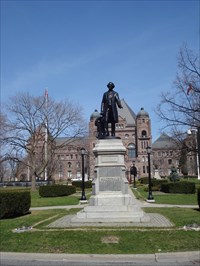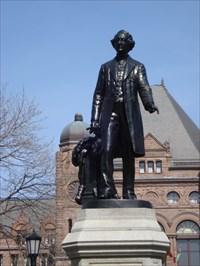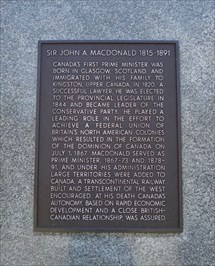


Text from the plaque:
Sir John A. Macdonald 1815 - 1891
Canada's first Prime Minister was born in Glasgow, Scotland, and immigrated with his family to Kingston, Upper Canada, in 1820. A successful lawyer, he was elected to the provincial legislature in 1844 and became leader of the Conservative Party. He played a leading role in the effort to achieve a federal union of Britain's North American colonies which resulted in the formation of the Dominion of Canada on July 1, 1867. Macdonald served as Prime Minister, 1867-73 and 1878-91, and under his administration large territories were added to Canada, a transcontinental railroad built and settlement of the west encouraged. At his death Canada's autonomy, based on rapid economic development and a close British-Canadian relationship, was assured.
Sir John A. Macdonald: Father of Confederation
Born in Glasgow, Scotland on January 11, 1815, John Alexander Macdonald emigrated to Canada with his parents at age five. Macdonald attended the Midland Grammar and the John Cruickshank School in Kingston before articling with George Mackenzie, a Kingston lawyer. Mackenzie was so impressed with Macdonald that he sent him to open a law office in Napanee. When Mackenzie died in 1835, Macdonald returned to Kingston to open his own legal practice. In 1836, he was called to the bar.
By 1843, Macdonald's law office had become one of the busiest in Canada. The following year, he was appointed as a city councillor. In 1844 Macdonald decided to run for a seat in the Legislative Assembly of Canada, which then consisted of Canada West (formerly Upper Canada) and Canada East (formerly Lower Canada, now Quebec). The two colonies were divided by nationality, with English prominent in the West, and French in the east. Both colonies voted separately and each named a Premier. Macdonald won by a large majority and was elected as the Conservative (Tory) representative for Kingston.
Macdonald was a staunch supporter of the Conservative Party. The election of 1848 saw the Conservatives lose to the Reformers, a rival party. Macdonald was one of the few Conservatives to retain his seat. Over the next few years, he endeavored to broaden the appeal of his party. Macdonald's efforts were recognized in 1854 when the Conservatives and the radical Clear Grits (Liberals) defeated the Reform Party.
Macdonald worked diligently to keep the Conservative Party in power and throughout the early 1860's supported the Confederation movement. Although some politicians were in favour of annexation by the United States, Macdonald argued for union of the country.
On July 1, 1867, the British parliament passed the British North American Act. This Act established the Dominion of Canada and gave the Canadian government the right to pass laws. The colonies of Nova Scotia, New Brunswick and Canada were united and the province of Canada was divided into the provinces of Quebec and Ontario. A provision was included in the Act that allowed for the other colonies and territories of British North America to join confederation.
Macdonald was appointed Prime Minister of Canada in 1867 and won the federal election in August. During his two terms as Prime Minister he was instrumental in bringing the Hudson's Bay Company land territory under Canadian control, negotiated the entry of British Columbia and Prince Edward Island into the Canadian federation and helped establish the province of Manitoba
Macdonald was also involved in building the Canadian Pacific railway system, a venture that was fraught with difficulties and scandal. Revelations of shady dealings between the Conservatives and the company retained to build the railway, led to the Pacific Scandal in 1873. Macdonald's government was forced to resign and lost the election in 1874.
Macdonald regained power in 1878, however, political unrest continued. His handling of the Northwest Rebellion in 1885 and execution of Louis Riel outraged French Canadians, sparking a conflict between the French and the English that is still ongoing.
In March 1891, Macdonald won his fourth consecutive electoral victory. He died three months later and was buried next to his mother in Kingston.
Information from: visit website